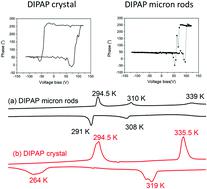当前位置:
X-MOL 学术
›
Phys. Chem. Chem. Phys.
›
论文详情
Our official English website, www.x-mol.net, welcomes your
feedback! (Note: you will need to create a separate account there.)
Spontaneous self-formation of molecular ferroelectric heterostructures
Physical Chemistry Chemical Physics ( IF 2.9 ) Pub Date : 2021-1-14 , DOI: 10.1039/d0cp06060g Kaige Gao 1, 2, 3, 4 , Zhen Su 1, 2, 3, 4 , Chen Li 4, 5, 6, 7, 8 , Di Wu 4, 5, 6, 7, 8 , Binbin Zhang 4, 9, 10
Physical Chemistry Chemical Physics ( IF 2.9 ) Pub Date : 2021-1-14 , DOI: 10.1039/d0cp06060g Kaige Gao 1, 2, 3, 4 , Zhen Su 1, 2, 3, 4 , Chen Li 4, 5, 6, 7, 8 , Di Wu 4, 5, 6, 7, 8 , Binbin Zhang 4, 9, 10
Affiliation

|
A new phase of diisopropylammonium perchlorate (DIPAP) forms during freeze-drying or heat treatment, which generates the heterostructure with its original ferroelectric phase. There is no composition fluctuation in the DIPAP molecular ferroelectric heterostructures, but there is an interface between the two phases of DIPAP. The formation of the new phase resembles that of martensite in alloys. A large internal bias field that is almost 2.5 times of the coercive field was found in the molecular ferroelectric heterostructures, which is comparable to that of doped triglycine sulfate. The large internal bias field will promote the ability of the DIPAP heterostructure to adsorb PM2.5 under light. The spontaneous self-formation of molecular ferroelectric heterostructures may help improve the performance of molecular ferroelectric devices.
中文翻译:

分子铁电异质结构的自发形成
在冷冻干燥或热处理过程中会形成新的高氯酸二异丙基铵(DIPAP)相,并在其原始铁电相中产生异质结构。DIPAP分子铁电异质结构中没有成分波动,但DIPAP的两相之间存在界面。新相的形成类似于合金中的马氏体。在分子铁电异质结构中发现了一个大的内部偏置场,几乎是矫顽场的2.5倍,这与掺杂的硫酸三甘氨酸相当。大的内部偏置场将提高DIPAP异质结构吸附PM 2.5的能力在光下。分子铁电异质结构的自发自形成可能有助于改善分子铁电器件的性能。
更新日期:2021-01-27
中文翻译:

分子铁电异质结构的自发形成
在冷冻干燥或热处理过程中会形成新的高氯酸二异丙基铵(DIPAP)相,并在其原始铁电相中产生异质结构。DIPAP分子铁电异质结构中没有成分波动,但DIPAP的两相之间存在界面。新相的形成类似于合金中的马氏体。在分子铁电异质结构中发现了一个大的内部偏置场,几乎是矫顽场的2.5倍,这与掺杂的硫酸三甘氨酸相当。大的内部偏置场将提高DIPAP异质结构吸附PM 2.5的能力在光下。分子铁电异质结构的自发自形成可能有助于改善分子铁电器件的性能。











































 京公网安备 11010802027423号
京公网安备 11010802027423号